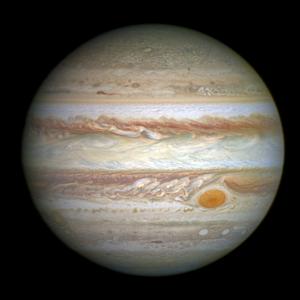Stripes, belts, and the Great Red Spot decorate Jupiter, the largest planet in the solar system, in this natural-color view from Hubble Space Telescope. Jupiter and Earth are at their closest for the year in May, when Jupiter will shine as the third-brightest object in the night sky (only Venus and the Moon outperform it). Jupiter spans about 88,000 miles, and its Great Red Spot is as wide as Earth. [NASA/ESA/A. Simon (GSFC)]
You are here
Jupiter at Opposition
It’s amazing what a difference a few centuries can make.
Consider Jupiter, the largest planet in the solar system. It shines at its best for the year this week. It’s at opposition — it lines up opposite the Sun. It rises at sunset, scoots low across the south during the night, and sets around sunrise. It’s brightest for the year, too, outshining everything else in the night sky except the Moon and Venus.
When people first looked at Jupiter and the other planets, they saw bright lights moving across the background of stars. Over time, though, they noticed patterns in their motions. Combined with their brightness and color, that appeared to give each planet a personality.
Jupiter, for example, is quite bright, and it takes about 12 years to complete a circle against the background of stars. That gave it a regal quality. So early cultures thought of it as the most majestic of their gods. To the Greeks he was Zeus, the king of the gods. The Romans adopted him as Jupiter.
Centuries later, scientists realized the lights were heavenly bodies, moving along predictable paths. And in the 17th century, Galileo saw Jupiter as a world in its own right, orbited by its own moons.
In the centuries since, better telescopes have revealed that Jupiter is a giant ball of gas. Stripes of clouds and mammoth storms decorate its upper atmosphere. They give Jupiter its own appearance and personality — the king of the planets.
More tomorrow.
Script by Damond Benningfield
Get Premium Audio
Listen to today's episode of StarDate on the web the same day it airs in high-quality streaming audio without any extra ads or announcements. Choose a $8 one-month pass, or listen every day for a year for just $30.







